
List of UNESCO World Heritage Sites in the United Kingdom
Encyclopedia
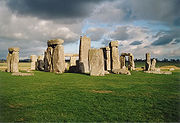
UNESCO
The United Nations Educational, Scientific and Cultural Organization is a specialized agency of the United Nations...
World Heritage Site
World Heritage Site
A UNESCO World Heritage Site is a place that is listed by the UNESCO as of special cultural or physical significance...
s in the United Kingdom and overseas territories
British overseas territories
The British Overseas Territories are fourteen territories of the United Kingdom which, although they do not form part of the United Kingdom itself, fall under its jurisdiction. They are remnants of the British Empire that have not acquired independence or have voted to remain British territories...
. The UNESCO list contains seventeen designated properties in England (the Frontiers of the Roman Empire
Limes
A limes was a border defense or delimiting system of Ancient Rome. It marked the boundaries of the Roman Empire.The Latin noun limes had a number of different meanings: a path or balk delimiting fields, a boundary line or marker, any road or path, any channel, such as a stream channel, or any...
is shared with Germany
Germany
Germany , officially the Federal Republic of Germany , is a federal parliamentary republic in Europe. The country consists of 16 states while the capital and largest city is Berlin. Germany covers an area of 357,021 km2 and has a largely temperate seasonal climate...
), four in Scotland, three in Wales, one in Northern Ireland
Northern Ireland
Northern Ireland is one of the four countries of the United Kingdom. Situated in the north-east of the island of Ireland, it shares a border with the Republic of Ireland to the south and west...
, and one in each of the overseas territories of Bermuda
Bermuda
Bermuda is a British overseas territory in the North Atlantic Ocean. Located off the east coast of the United States, its nearest landmass is Cape Hatteras, North Carolina, about to the west-northwest. It is about south of Halifax, Nova Scotia, Canada, and northeast of Miami, Florida...
, the Pitcairn Islands
Pitcairn Islands
The Pitcairn Islands , officially named the Pitcairn, Henderson, Ducie and Oeno Islands, form a group of four volcanic islands in the southern Pacific Ocean. The islands are a British Overseas Territory and overseas territory of the European Union in the Pacific...
, and Saint Helena
Saint Helena
Saint Helena , named after St Helena of Constantinople, is an island of volcanic origin in the South Atlantic Ocean. It is part of the British overseas territory of Saint Helena, Ascension and Tristan da Cunha which also includes Ascension Island and the islands of Tristan da Cunha...
. The first sites in the UK to be inscribed on the World Heritage List were Giant's Causeway and Causeway Coast
Giant's Causeway
The Giant's Causeway is an area of about 40,000 interlocking basalt columns, the result of an ancient volcanic eruption. It is located in County Antrim on the northeast coast of Northern Ireland, about three miles northeast of the town of Bushmills...
; Durham Castle
Durham Castle
Durham Castle is a Norman castle in the city of Durham, England, which has been wholly occupied since 1840 by University College, Durham. It is open to the general public to visit, but only through guided tours, since it is in use as a working building and is home to over 100 students...
and Cathedral
Durham Cathedral
The Cathedral Church of Christ, Blessed Mary the Virgin and St Cuthbert of Durham is a cathedral in the city of Durham, England, the seat of the Anglican Bishop of Durham. The Bishopric dates from 995, with the present cathedral being founded in AD 1093...
; Ironbridge Gorge
Ironbridge Gorge
The Ironbridge Gorge is a deep gorge formed by the River Severn in Shropshire, England.Originally called the Severn Gorge, the gorge now takes its name from its famous Iron Bridge, the first iron bridge of its kind in the world, and a monument to the industry that began there...
; Studley Royal Park
Studley Royal Park
Studley Royal Park is a park containing, and developed around, the ruins of the Cistercian Fountains Abbey in North Yorkshire, England. It is a World Heritage Site. The site also contains features dating from the eighteenth century such as Studley Royal Water Garden.-Origins:The Fountains Abbey was...
including the Ruins of Fountains Abbey
Fountains Abbey
Fountains Abbey is near to Aldfield, approximately two miles southwest of Ripon in North Yorkshire, England. It is a ruined Cistercian monastery, founded in 1132. Fountains Abbey is one of the largest and best preserved Cistercian houses in England. It is a Grade I listed building and owned by the...
; Stonehenge, Avebury and Associated Sites
Stonehenge, Avebury and Associated Sites
Stonehenge, Avebury and Associated Sites is a UNESCO World Heritage Site located in Wiltshire, England. The WHS covers two large areas of land separated by nearly , rather than a specific monument or building. The sites were inscribed as co-listings in 1986....
; and the Castles and Town Walls of King Edward in Gwynedd
Castles and Town Walls of King Edward in Gwynedd
The Castles and Town Walls of King Edward in Gwynedd refers to a UNESCO-designated site of patrimony located in Gwynedd, Wales.In 1986, four castles related to the reign of King Edward I of England were proclaimed collectively as a World Heritage Site, as outstanding examples of fortifications and...
in 1986. The latest site to be inscribed was Pontcysyllte Aqueduct and Canal
Pontcysyllte Aqueduct
The Pontcysyllte Aqueduct is a navigable aqueduct that carries the Llangollen Canal over the valley of the River Dee in Wrexham in north east Wales....
in 2009.
The constitution of the United Nations Educational, Scientific and Cultural Organization (commonly referred to as UNESCO) was ratified in 1946 by 26 countries, including the UK. Its purpose was to provide for the "conservation and protection of the world’s inheritance of books, works of art and monuments of history and science". The UK contributes £130,000 annually to the World Heritage Fund which finances the preservation of sites in developing countries
Developing country
A developing country, also known as a less-developed country, is a nation with a low level of material well-being. Since no single definition of the term developing country is recognized internationally, the levels of development may vary widely within so-called developing countries...
. Some designated properties contain multiple sites that share a common geographical location or cultural heritage.
The United Kingdom National Commission for UNESCO advises the British government, which is responsible for maintaining its World Heritage Sites, on policies regarding UNESCO. In 2008, Andy Burnham – then Minister for Culture, Media, and Sport
Department for Culture, Media and Sport
The Department for Culture, Media and Sport is a department of the United Kingdom government, with responsibility for culture and sport in England, and some aspects of the media throughout the whole UK, such as broadcasting and internet....
– voiced concerns over the worth of the designation of sites in the UK as World Heritage Sites and called for a review of the government's policy of putting forward new sites; this was partly due to rising costs and lower-than-expected income from visitors, few of which were aware of the World Heritage Site status of the sites they visited.
World Heritage Site selection criteria i–iv are culturally related, and selection criteria vii–x are the natural criteria. Twenty-three properties are designated as "cultural", four as "natural", and one as "mixed".A mixed site is one that falls under both natural and cultural criteria. The breakdown of sites by type was similar to the overall proportions; of the 890 sites on the World Heritage List, 77.4% are cultural, 19.8% are natural, and 2.8% are mixed. St Kilda
St Kilda, Scotland
St Kilda is an isolated archipelago west-northwest of North Uist in the North Atlantic Ocean. It contains the westernmost islands of the Outer Hebrides of Scotland. The largest island is Hirta, whose sea cliffs are the highest in the United Kingdom and three other islands , were also used for...
is the only mixed World Heritage Site in the UK. Originally preserved for its natural habitats alone, in 2005 the site was expanded to include the crofting
Crofting
Crofting is a form of land tenure and small-scale food production unique to the Scottish Highlands, the Islands of Scotland, and formerly on the Isle of Man....
community that once inhabited the archipelago
Archipelago
An archipelago , sometimes called an island group, is a chain or cluster of islands. The word archipelago is derived from the Greek ἄρχι- – arkhi- and πέλαγος – pélagos through the Italian arcipelago...
; the site became one of only 25 mixed sites worldwide. The natural sites are the Dorset and East Devon Coast
Jurassic Coast
The Jurassic Coast is a World Heritage Site on the English Channel coast of southern England. The site stretches from Orcombe Point near Exmouth in East Devon to Old Harry Rocks near Swanage in East Dorset, a distance of ....
; Giant's Causeway and Causeway Coast; Gough
Gough Island
Gough Island , also known historically as Gonçalo Álvares or Diego Alvarez, is a volcanic island in the South Atlantic Ocean. It is a dependency of Tristan da Cunha and part of the British overseas territory of Saint Helena, Ascension and Tristan da Cunha...
and Inaccessible Island
Inaccessible Island
Inaccessible Island is an extinct volcano, 14 km² in area, rising out of the South Atlantic Ocean 45 km southwest of Tristan da Cunha. Inaccessible Island is located at . It is part of the archipelago of Tristan da Cunha, which is part of the overseas territory of the United Kingdom,...
s; and Henderson Island
Henderson Island (Pitcairn Islands)
Henderson Island is an uninhabited raised coral atoll in the south Pacific Ocean, that in 1902 was annexed to the Pitcairn Islands colony, a South Pacific Dependent Territory of the United Kingdom. Measuring long and wide, it has an area of and is located northeast of Pitcairn Island at . The...
. The rest are cultural.
World Heritage Sites
The table lists information about each World Heritage Site:- Name; as listed by the World Heritage CommitteeWorld Heritage CommitteeThe World Heritage Committee establishes the sites to be listed as UNESCO World Heritage Sites. It is responsible for the implementation of the World Heritage Convention, defines the use of the World Heritage Fund and allocates financial assistance upon requests from States Parties...
- Location; in one of the UK's constituent countries and overseas territories, with co-ordinates provided by UNESCO
- Period; time period of significance, typically of construction
- UNESCO data; Site reference number, the year the site was inscribed on the World Heritage List, and the criteria it was listed under
- Description; brief description of the site
| Name | Image | Location | Date | UNESCO data | Description |
|---|---|---|---|---|---|
| Blaenavon Industrial Landscape |  |
51.78°N 3.08°W |
19th century | In the 19th century, Wales was the world's foremost producer of iron and coal. Blaenavon is an example of the landscape created by the industrial processes associated with the production of these materials. The site includes quarries, public buildings, workers' housing, and a railway. | |
| Blenheim Palace Blenheim Palace Blenheim Palace is a monumental country house situated in Woodstock, Oxfordshire, England, residence of the dukes of Marlborough. It is the only non-royal non-episcopal country house in England to hold the title of palace. The palace, one of England's largest houses, was built between... |
51.841944°N 1.361389°W |
Blenheim Palace, the residence of John Churchill, 1st Duke of Marlborough John Churchill, 1st Duke of Marlborough John Churchill, 1st Duke of Marlborough, Prince of Mindelheim, KG, PC , was an English soldier and statesman whose career spanned the reigns of five monarchs through the late 17th and early 18th centuries... , was designed by architects John Vanbrugh John Vanbrugh Sir John Vanbrugh – 26 March 1726) was an English architect and dramatist, perhaps best known as the designer of Blenheim Palace and Castle Howard. He wrote two argumentative and outspoken Restoration comedies, The Relapse and The Provoked Wife , which have become enduring stage favourites... and Nicholas Hawksmoor Nicholas Hawksmoor Nicholas Hawksmoor was a British architect born in Nottinghamshire, probably in East Drayton.-Life:Hawksmoor was born in Nottinghamshire in 1661, into a yeoman farming family, almost certainly in East Drayton, Nottinghamshire. On his death he was to leave property at nearby Ragnall, Dunham and a... . The associated park was landscaped by Capability Brown. The palace celebrated victory over the French and is significant for establishing English Romantic Architecture as a separate entity from French Classical Architecture. |
|||
| Canterbury Cathedral Canterbury Cathedral Canterbury Cathedral in Canterbury, Kent, is one of the oldest and most famous Christian structures in England and forms part of a World Heritage Site.... , St Augustine's Abbey St Augustine's Abbey St Augustine's Abbey was a Benedictine abbey in Canterbury, Kent, England.-Early history:In 597 Saint Augustine arrived in England, having been sent by Pope Gregory I, on what might nowadays be called a revival mission. The King of Kent at this time was Æthelberht, who happened to be married to a... , and St Martin's Church St Martin's Church, Canterbury The Church of St Martin in Canterbury, England, situated slightly beyond the city centre, is England's oldest parish church in continuous use. Since 1668 St Martin's has been part of the benefice of St Martin & St Paul Canterbury. Both St Martin's and nearby St Paul's churches are used for weekly... |
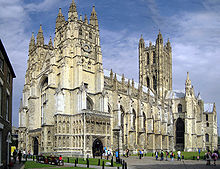 |
51.28°N 1.083056°W |
St Martin's Church is the oldest church in England. The church and St Augustine's Abbey were founded during the early stages of the introduction of Christianity to the Anglo-Saxons. The cathedral exhibits Romanesque Romanesque architecture Romanesque architecture is an architectural style of Medieval Europe characterised by semi-circular arches. There is no consensus for the beginning date of the Romanesque architecture, with proposals ranging from the 6th to the 10th century. It developed in the 12th century into the Gothic style,... and Gothic architecture Gothic architecture Gothic architecture is a style of architecture that flourished during the high and late medieval period. It evolved from Romanesque architecture and was succeeded by Renaissance architecture.... , and is the seat of the Church of England Church of England The Church of England is the officially established Christian church in England and the Mother Church of the worldwide Anglican Communion. The church considers itself within the tradition of Western Christianity and dates its formal establishment principally to the mission to England by St... . |
||
| Castles and Town Walls of King Edward in Gwynedd Castles and Town Walls of King Edward in Gwynedd The Castles and Town Walls of King Edward in Gwynedd refers to a UNESCO-designated site of patrimony located in Gwynedd, Wales.In 1986, four castles related to the reign of King Edward I of England were proclaimed collectively as a World Heritage Site, as outstanding examples of fortifications and... |
53.139722°N 4.276944°W |
During the reign of Edward I of England Edward I of England Edward I , also known as Edward Longshanks and the Hammer of the Scots, was King of England from 1272 to 1307. The first son of Henry III, Edward was involved early in the political intrigues of his father's reign, which included an outright rebellion by the English barons... (1272–1307), a series of castles were constructed in Wales with the purpose of subduing the population and establishing English colonies in Wales. The World Heritage Site covers many castles including Beaumaris Beaumaris Castle Beaumaris Castle, located in the town of the same name on the Isle of Anglesey in Wales, was built as part of King Edward I's campaign to conquer the north of Wales. It was designed by James of St. George and was begun in 1295, but never completed... , Caernarfon Caernarfon Castle Caernarfon Castle is a medieval building in Gwynedd, north-west Wales. There was a motte-and-bailey castle in the town of Caernarfon from the late 11th century until 1283 when King Edward I of England began replacing it with the current stone structure... , Conwy Conwy Castle Conwy Castle is a castle in Conwy, on the north coast of Wales.It was built between 1283 and 1289 during King Edward I's second campaign in North Wales.... , and Harlech Harlech Castle Harlech Castle, located in Harlech, Gwynedd, Wales, is a concentric castle, constructed atop a cliff close to the Irish Sea. Architecturally, it is particularly notable for its massive gatehouse.... . The castles of Edward I are considered the pinnacle of military architecture by military historians. |
|||
| City of Bath |  |
51.3809°N 2.3603°W |
Founded by the Romans as a spa, an important centre of the wool industry in the medieval period, and a spa town in the 18th century, Bath has a varied history. The city is preserved for its Roman remains and Palladian architecture Palladian architecture Palladian architecture is a European style of architecture derived from the designs of the Venetian architect Andrea Palladio . The term "Palladian" normally refers to buildings in a style inspired by Palladio's own work; that which is recognised as Palladian architecture today is an evolution of... . |
||
| Cornwall and West Devon Mining Landscape Cornwall and West Devon Mining Landscape The Cornwall and West Devon Mining Landscape is a World Heritage Site which includes select mining landscapes across Cornwall and West Devon in the south west of the United Kingdom... |
 |
50.136111°N 5.383611°W |
18th and 19th centuries | Tin and copper mining in Devon and Cornwall boomed in the 18th and 19th centuries, and at its peak the area produced two-thirds of the world's copper. The techniques and technology involved in deep mining developed in Devon and Cornwall were used around the world. | |
| Derwent Valley Mills Derwent Valley Mills Derwent Valley Mills is a World Heritage Site along the River Derwent in Derbyshire, England, designated in December 2001. It is administered by the Derwent Valley Mills Partnership. The modern factory, or 'mill', system was born here in the 18th century to accommodate the new technology for... |
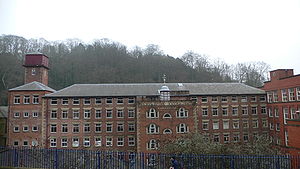 |
53.020278°N 1.499722°W |
18th and 19th centuries | The Derwent Valley Mills was the birthplace of the factory system Factory system The factory system was a method of manufacturing first adopted in England at the beginning of the Industrial Revolution in the 1750s and later spread abroad. Fundamentally, each worker created a separate part of the total assembly of a product, thus increasing the efficiency of factories. Workers,... ; the innovations in the valley, including the development of workers' housing – such as at Cromford Cromford Cromford is a village, two miles to the south of Matlock in the Derbyshire Dales district in Derbyshire, England. It is principally known for its historical connection with Richard Arkwright, and the Cromford Mill which he built here in 1771... – and machines such as the water frame Water frame The water frame is the name given to the spinning frame, when water power is used to drive it. Both are credited to Richard Arkwright who patented the technology in 1768. It was based on an invention by Thomas Highs and the patent was later overturned... , were important in the Industrial Revolution Industrial Revolution The Industrial Revolution was a period from the 18th to the 19th century where major changes in agriculture, manufacturing, mining, transportation, and technology had a profound effect on the social, economic and cultural conditions of the times... . The Derwent Valley Mills influenced North America and Europe. |
|
| Dorset and East Devon Coast Jurassic Coast The Jurassic Coast is a World Heritage Site on the English Channel coast of southern England. The site stretches from Orcombe Point near Exmouth in East Devon to Old Harry Rocks near Swanage in East Dorset, a distance of .... |
 |
50.705556°N 2.989889°W |
n/a | The cliffs that make up the Dorset and Devon coast are an important site for fossils and provide a continuous record of life on land and in the sea in the area since 185 million years ago. | |
| Durham Castle Durham Castle Durham Castle is a Norman castle in the city of Durham, England, which has been wholly occupied since 1840 by University College, Durham. It is open to the general public to visit, but only through guided tours, since it is in use as a working building and is home to over 100 students... and Cathedral Durham Cathedral The Cathedral Church of Christ, Blessed Mary the Virgin and St Cuthbert of Durham is a cathedral in the city of Durham, England, the seat of the Anglican Bishop of Durham. The Bishopric dates from 995, with the present cathedral being founded in AD 1093... |
54.77487°N 1.57558°W |
Durham Cathedral is the "largest and finest" example of Norman architecture Norman architecture About|Romanesque architecture, primarily English|other buildings in Normandy|Architecture of Normandy.File:Durham Cathedral. Nave by James Valentine c.1890.jpg|thumb|200px|The nave of Durham Cathedral demonstrates the characteristic round arched style, though use of shallow pointed arches above the... in England and vaulting of the cathedral was part of the advent of Gothic architecture Gothic architecture Gothic architecture is a style of architecture that flourished during the high and late medieval period. It evolved from Romanesque architecture and was succeeded by Renaissance architecture.... . The cathedral houses relics of St Cuthbert Cuthbert of Lindisfarne Saint Cuthbert was an Anglo-Saxon monk, bishop and hermit associated with the monasteries of Melrose and Lindisfarne in the Kingdom of Northumbria, at that time including, in modern terms, northern England as well as south-eastern Scotland as far as the Firth of Forth... and Bede Bede Bede , also referred to as Saint Bede or the Venerable Bede , was a monk at the Northumbrian monastery of Saint Peter at Monkwearmouth, today part of Sunderland, England, and of its companion monastery, Saint Paul's, in modern Jarrow , both in the Kingdom of Northumbria... . The Norman castle was the residence of the Durham prince-bishops. |
|||
| Frontiers of the Roman Empire Limes A limes was a border defense or delimiting system of Ancient Rome. It marked the boundaries of the Roman Empire.The Latin noun limes had a number of different meanings: a path or balk delimiting fields, a boundary line or marker, any road or path, any channel, such as a stream channel, or any... |
 |
54.992611°N 2.601°W |
Hadrian's Wall Hadrian's Wall Hadrian's Wall was a defensive fortification in Roman Britain. Begun in AD 122, during the rule of emperor Hadrian, it was the first of two fortifications built across Great Britain, the second being the Antonine Wall, lesser known of the two because its physical remains are less evident today.The... was built in 122 AD and the Antonine Wall Antonine Wall The Antonine Wall is a stone and turf fortification built by the Romans across what is now the Central Belt of Scotland, between the Firth of Forth and the Firth of Clyde. Representing the northernmost frontier barrier of the Roman Empire, it spanned approximately 39 miles and was about ten feet ... was constructed in 142 AD to defend the Roman Empire Roman Empire The Roman Empire was the post-Republican period of the ancient Roman civilization, characterised by an autocratic form of government and large territorial holdings in Europe and around the Mediterranean.... from "barbarians". The World Heritage Site was previously listed as Hadrian's Wall alone, but was later expanded to include all the frontiers of the Roman Empire at its zenith in the 2nd century, ranging from Antonine's Wall in the north to Trajan's Wall Trajan's Wall Trajan's Wall is a complex of valla in Eastern Europe: in Romania, Moldova and Ukraine.Contrary to the name and popular belief, the ramparts were not built by Romans during Trajan's reign.-Romania:... in eastern Europe. |
||
| Giant's Causeway and Causeway Coast Giant's Causeway The Giant's Causeway is an area of about 40,000 interlocking basalt columns, the result of an ancient volcanic eruption. It is located in County Antrim on the northeast coast of Northern Ireland, about three miles northeast of the town of Bushmills... |
 |
55.240833°N 6.511667°W |
The causeway is made up of 40,000 basalt Basalt Basalt is a common extrusive volcanic rock. It is usually grey to black and fine-grained due to rapid cooling of lava at the surface of a planet. It may be porphyritic containing larger crystals in a fine matrix, or vesicular, or frothy scoria. Unweathered basalt is black or grey... columns projecting out of the sea. It was created by volcanic activity in the Tertiary period. |
||
| Gough Gough Island Gough Island , also known historically as Gonçalo Álvares or Diego Alvarez, is a volcanic island in the South Atlantic Ocean. It is a dependency of Tristan da Cunha and part of the British overseas territory of Saint Helena, Ascension and Tristan da Cunha... and Inaccessible Island Inaccessible Island Inaccessible Island is an extinct volcano, 14 km² in area, rising out of the South Atlantic Ocean 45 km southwest of Tristan da Cunha. Inaccessible Island is located at . It is part of the archipelago of Tristan da Cunha, which is part of the overseas territory of the United Kingdom,... |
 |
40.3181°N 9.9353°W |
n/a | Together, the Gough and Inaccessible Islands preserve an ecosystem almost untouched by mankind, with many native species of plants and animals. | |
| Heart of Neolithic Orkney Heart of Neolithic Orkney Heart of Neolithic Orkney refers to a group of Neolithic monuments found on the Mainland, one of the islands of Orkney, Scotland. The name was adopted by UNESCO when it proclaimed these sites as a World Heritage Site in 1999.... |
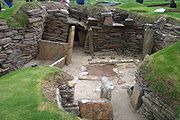 |
58.996056°N 3.188667°W |
A collection of Neolithic sites with purposes ranging from occupation to ceremony. It includes the settlement of Skara Brae Skara Brae Skara Brae is a large stone-built Neolithic settlement, located on the Bay of Skaill on the west coast of Mainland, Orkney, Scotland. It consists of ten clustered houses, and was occupied from roughly 3180 BCE–2500 BCE... , the chambered tomb of Maes Howe and the stone circles of Stenness Stones of Stenness The Standing Stones of Stenness is a Neolithic monument on the mainland of Orkney, Scotland. Various traditions associated with the stones survived into the modern era and they form part of the Heart of Neolithic Orkney World Heritage Site... and Brodgar Ring of Brodgar The Ring of Brodgar is a Neolithic henge and stone circle on the Mainland, the largest island in Orkney, Scotland... . |
||
| Henderson Island Henderson Island (Pitcairn Islands) Henderson Island is an uninhabited raised coral atoll in the south Pacific Ocean, that in 1902 was annexed to the Pitcairn Islands colony, a South Pacific Dependent Territory of the United Kingdom. Measuring long and wide, it has an area of and is located northeast of Pitcairn Island at . The... |
 |
24.35°N 128.316667°W |
n/a | The island is an atoll Atoll An atoll is a coral island that encircles a lagoon partially or completely.- Usage :The word atoll comes from the Dhivehi word atholhu OED... in the south of the Pacific Ocean, the ecology of which has been almost untouched by man and its isolation illustrates the dynamics of evolution. There are ten plant and four animal species native to the island. |
|
| Historic Town of St George St. George's, Bermuda St. George's , located on the island and within the parish of the same names, was the first permanent settlement on the islands of Bermuda, and is often described as the third successful English settlement in the Americas, after St. John's, Newfoundland, and Jamestown, Virginia. However, St... and Related Fortifications Castle Islands Fortifications, Bermuda Several of the islands strung across the South entrance of Castle Harbour, Bermuda were fortified in the early days of the territory, hence the harbour's name. When official settlement of the archipelago by England began in 1612 the first permanent town, St... , Bermuda |
51.3809°N 2.3603°W |
Founded in 1612, St George is the oldest English town in the New World and an example of planned urban settlements established in the New World in the 17th century by colonial powers. The fortifications illustrate defensive techniques developed through the 17th to 20th centuries. | |||
| Ironbridge Gorge Ironbridge Gorge The Ironbridge Gorge is a deep gorge formed by the River Severn in Shropshire, England.Originally called the Severn Gorge, the gorge now takes its name from its famous Iron Bridge, the first iron bridge of its kind in the world, and a monument to the industry that began there... |
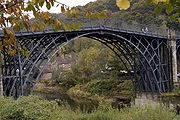 |
52.62646°N 2.486°W |
Ironbridge Gorge contains mines, factories, workers' housing, and the transport infrastructure that was created in the gorge during the Industrial Revolution Industrial Revolution The Industrial Revolution was a period from the 18th to the 19th century where major changes in agriculture, manufacturing, mining, transportation, and technology had a profound effect on the social, economic and cultural conditions of the times... . The development of coke Coke (fuel) Coke is the solid carbonaceous material derived from destructive distillation of low-ash, low-sulfur bituminous coal. Cokes from coal are grey, hard, and porous. While coke can be formed naturally, the commonly used form is man-made.- History :... production in the area helped start the Industrial Revolution. The Iron Bridge The Iron Bridge The Iron Bridge crosses the River Severn at the Ironbridge Gorge, by the village of Ironbridge, in Shropshire, England. It was the first arch bridge in the world to be made out of cast iron, a material which was previously far too expensive to use for large structures... was the world's first bridge built from iron and was architecturally and technologically influential. |
||
| Liverpool – Maritime Mercantile City Liverpool Maritime Mercantile City The Liverpool Maritime Mercantile City is a UNESCO designated World Heritage Site in Liverpool, England. It comprises six locations in the city centre of Liverpool including the Pier Head, Albert Dock and William Brown Street, and includes many of the city's most famous landmarks.UNESCO received... |
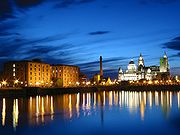 |
53.40°N 2.99°W |
18th and 19th centuries | In the 18th and 19th centuries, Liverpool was one of the largest ports in the world. Its global connections helped sustain the British Empire British Empire The British Empire comprised the dominions, colonies, protectorates, mandates and other territories ruled or administered by the United Kingdom. It originated with the overseas colonies and trading posts established by England in the late 16th and early 17th centuries. At its height, it was the... , and it was a major port involved in the slave trade History of slavery The history of slavery covers slave systems in historical perspective in which one human being is legally the property of another, can be bought or sold, is not allowed to escape and must work for the owner without any choice involved... until its abolition in 1807, and a departure point for emigrants to North America. The docks were the site of innovations in construction and dock management. |
|
| Maritime Greenwich Greenwich Greenwich is a district of south London, England, located in the London Borough of Greenwich.Greenwich is best known for its maritime history and for giving its name to the Greenwich Meridian and Greenwich Mean Time... |
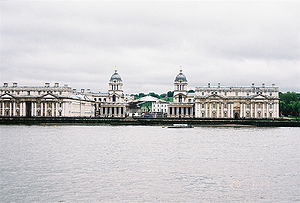 |
51.4791°N 0°W |
As well as the presence of the first example of Palladian architecture Palladian architecture Palladian architecture is a European style of architecture derived from the designs of the Venetian architect Andrea Palladio . The term "Palladian" normally refers to buildings in a style inspired by Palladio's own work; that which is recognised as Palladian architecture today is an evolution of... in England, and works by Christopher Wren Christopher Wren Sir Christopher Wren FRS is one of the most highly acclaimed English architects in history.He used to be accorded responsibility for rebuilding 51 churches in the City of London after the Great Fire in 1666, including his masterpiece, St. Paul's Cathedral, on Ludgate Hill, completed in 1710... and Inigo Jones Inigo Jones Inigo Jones is the first significant British architect of the modern period, and the first to bring Italianate Renaissance architecture to England... , the area is significant for the Royal Observatory Royal Observatory, Greenwich The Royal Observatory, Greenwich , in London, England played a major role in the history of astronomy and navigation, and is best known as the location of the prime meridian... where the understanding of astronomy and navigation were developed. |
||
| New Lanark New Lanark New Lanark is a village on the River Clyde, approximately 1.4 miles from Lanark, in South Lanarkshire, Scotland. It was founded in 1786 by David Dale, who built cotton mills and housing for the mill workers. Dale built the mills there to take advantage of the water power provided by the river... |
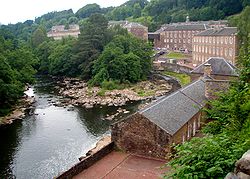 |
55.66°N 3.78°W |
19th century | Prompted by Richard Arkwright Richard Arkwright Sir Richard Arkwright , was an Englishman who, although the patents were eventually overturned, is often credited for inventing the spinning frame — later renamed the water frame following the transition to water power. He also patented a carding engine that could convert raw cotton into yarn... 's factory system Factory system The factory system was a method of manufacturing first adopted in England at the beginning of the Industrial Revolution in the 1750s and later spread abroad. Fundamentally, each worker created a separate part of the total assembly of a product, thus increasing the efficiency of factories. Workers,... developed in the Derwent Valley Derwent Valley Mills Derwent Valley Mills is a World Heritage Site along the River Derwent in Derbyshire, England, designated in December 2001. It is administered by the Derwent Valley Mills Partnership. The modern factory, or 'mill', system was born here in the 18th century to accommodate the new technology for... , the community of New Lanark was created to provide housing for workers at the mills. Philanthropist Robert Owen Robert Owen Robert Owen was a Welsh social reformer and one of the founders of utopian socialism and the cooperative movement.Owen's philosophy was based on three intellectual pillars:... bought the site and turned it into a model community, providing public facilities, education, and supporting factory reform. |
|
| Old and New Towns of Edinburgh Edinburgh Edinburgh is the capital city of Scotland, the second largest city in Scotland, and the eighth most populous in the United Kingdom. The City of Edinburgh Council governs one of Scotland's 32 local government council areas. The council area includes urban Edinburgh and a rural area... |
55.947572°N 3.191631°W |
The Old Town of Edinburgh was founded in the Middle Ages, and the New Town was developed in 1767–1890. It contrasts the layout of settlements in the medieval and modern periods. The layout and architecture of the new town, designed by luminaries such as William Chambers William Chambers (architect) Sir William Chambers was a Scottish architect, born in Gothenburg, Sweden, where his father was a merchant. Between 1740 and 1749 he was employed by the Swedish East India Company making several voyages to China where he studied Chinese architecture and decoration.Returning to Europe, he studied... and William Playfair William Playfair William Playfair was a Scottish engineer and political economist, the founder of graphical methods of statistics.... , influenced European urban design in the 18th and 19th centuries. |
|||
| Pontcysyllte Aqueduct and Canal Pontcysyllte Aqueduct The Pontcysyllte Aqueduct is a navigable aqueduct that carries the Llangollen Canal over the valley of the River Dee in Wrexham in north east Wales.... |
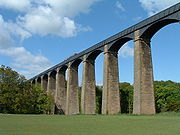 |
52.97053°N 3.08783°W |
The aqueduct was built to carry the Ellesmere Canal Ellesmere Canal The Ellesmere Canal was a canal in England and Wales, originally planned to link the Rivers Mersey, Dee, and Severn, by running from Netherpool to Shrewsbury. The canal that was eventually constructed was very different from what was originally envisioned... over the Dee Valley River Dee, Wales The River Dee is a long river in the United Kingdom. It travels through Wales and England and also forms part of the border between the two countries.... . Completed during the Industrial Revolution and designed by Thomas Telford Thomas Telford Thomas Telford FRS, FRSE was a Scottish civil engineer, architect and stonemason, and a noted road, bridge and canal builder.-Early career:... , the aqueduct made innovative use of cast Cast iron Cast iron is derived from pig iron, and while it usually refers to gray iron, it also identifies a large group of ferrous alloys which solidify with a eutectic. The color of a fractured surface can be used to identify an alloy. White cast iron is named after its white surface when fractured, due... and wrought iron Wrought iron thumb|The [[Eiffel tower]] is constructed from [[puddle iron]], a form of wrought ironWrought iron is an iron alloy with a very low carbon... , influencing civil engineering across the world. |
||
| Royal Botanical Gardens, Kew |  |
51.474667°N 0.295467°W |
18th–20th century | Created in 1759, the influential Kew Gardens were designed by Charles Bridgeman Charles Bridgeman Charles Bridgeman was an English garden designer in the onset of the naturalistic landscape style. Although he was a key figure in the transition of English garden design from the Anglo-Dutch formality of patterned parterres and avenues to a freer style that incorporated formal, structural and... , William Kent William Kent William Kent , born in Bridlington, Yorkshire, was an eminent English architect, landscape architect and furniture designer of the early 18th century.He was baptised as William Cant.-Education:... , Capability Brown Capability Brown Lancelot Brown , more commonly known as Capability Brown, was an English landscape architect. He is remembered as "the last of the great English eighteenth-century artists to be accorded his due", and "England's greatest gardener". He designed over 170 parks, many of which still endure... , and William Chambers William Chambers (architect) Sir William Chambers was a Scottish architect, born in Gothenburg, Sweden, where his father was a merchant. Between 1740 and 1749 he was employed by the Swedish East India Company making several voyages to China where he studied Chinese architecture and decoration.Returning to Europe, he studied... . The gardens were used to study botany and ecology and furthered the understanding of the subjects. |
|
| St Kilda St Kilda, Scotland St Kilda is an isolated archipelago west-northwest of North Uist in the North Atlantic Ocean. It contains the westernmost islands of the Outer Hebrides of Scotland. The largest island is Hirta, whose sea cliffs are the highest in the United Kingdom and three other islands , were also used for... |
 |
57.816667°N 8.583333°W |
n/a | Although inhabited for over 2,000 years, the isolated archipelago of St Kilda has had no permanent residents since 1930. The islands' human heritage includes various unique architectural features from the historic and prehistoric periods. St Kilda is also a breeding ground for many important seabird Seabird Seabirds are birds that have adapted to life within the marine environment. While seabirds vary greatly in lifestyle, behaviour and physiology, they often exhibit striking convergent evolution, as the same environmental problems and feeding niches have resulted in similar adaptations... species including the world's largest colony of gannets Northern Gannet The Northern Gannet is a seabird and is the largest member of the gannet family, Sulidae.- Description :Young birds are dark brown in their first year, and gradually acquire more white in subsequent seasons until they reach maturity after five years.Adults are long, weigh and have a wingspan... and up to 136,000 pairs of puffins Atlantic Puffin The Atlantic Puffin is a seabird species in the auk family. It is a pelagic bird that feeds primarily by diving for fish, but also eats other sea creatures, such as squid and crustaceans. Its most obvious characteristic during the breeding season is its brightly coloured bill... . |
|
| Saltaire Saltaire Saltaire is a Victorian model village within the City of Bradford Metropolitan District, West Yorkshire, England, by the River Aire and the Leeds and Liverpool Canal... |
 |
53.83717°N 1.79026°W |
Saltaire was founded by mill-owner Titus Salt Titus Salt Sir Titus Salt, 1st Baronet , born in Morley, near Leeds, was a manufacturer, politician and philanthropist in Bradford, West Yorkshire, England. His father Daniel Salt was a businessman and was sent Titus to Batley Grammar School... as a model village for his workers. The site, which includes the Salts Mill Salts Mill Salt's Mill is an art gallery, shopping and restaurant complex located in Saltaire, Bradford, West Yorkshire, England. It is inside a former mill, built by Sir Titus Salt. The 1853 gallery takes its name from the date of the building in which it is housed... , featured public buildings for the inhabitants and was an example of 19th century paternalism Paternalism Paternalism refers to attitudes or states of affairs that exemplify a traditional relationship between father and child. Two conditions of paternalism are usually identified: interference with liberty and a beneficent intention towards those whose liberty is interfered with... . |
||
| Stonehenge, Avebury and Associated Sites Stonehenge, Avebury and Associated Sites Stonehenge, Avebury and Associated Sites is a UNESCO World Heritage Site located in Wiltshire, England. The WHS covers two large areas of land separated by nearly , rather than a specific monument or building. The sites were inscribed as co-listings in 1986.... |
 |
51.178889°N 1.825278°W |
The Neolithic Neolithic The Neolithic Age, Era, or Period, or New Stone Age, was a period in the development of human technology, beginning about 9500 BC in some parts of the Middle East, and later in other parts of the world. It is traditionally considered as the last part of the Stone Age... sites of Avebury Avebury Avebury is a Neolithic henge monument containing three stone circles which is located around the village of Avebury in Wiltshire, south west England. Unique amongst megalithic monuments, Avebury contains the largest stone circle in Europe, and is one of the best known prehistoric sites in Britain... and Stonehenge Stonehenge Stonehenge is a prehistoric monument located in the English county of Wiltshire, about west of Amesbury and north of Salisbury. One of the most famous sites in the world, Stonehenge is composed of a circular setting of large standing stones set within earthworks... are two of the largest and most famous megalithic monuments in the world. They relate to man's interaction with his environment. The purpose of the henges has been a source of speculation, with suggestions ranging from ceremonial to interpreting the cosmos. "Associated sites" includes Silbury Hill Silbury Hill Silbury Hill is a prehistoric artificial chalk mound near Avebury in the English county of Wiltshire. It is part of the Stonehenge, Avebury and Associated Sites UNESCO World Heritage Site, and lies at .... , Beckhampton Avenue Beckhampton Avenue The Beckhampton Avenue a curving prehistoric avenue of stones that ran broadly south west from Avebury towards The Longstones at Beckhampton in the English county of Wiltshire. It probably dates to the late Neolithic and early Bronze Age.... , and West Kennet Avenue. |
||
| Studley Royal Park Studley Royal Park Studley Royal Park is a park containing, and developed around, the ruins of the Cistercian Fountains Abbey in North Yorkshire, England. It is a World Heritage Site. The site also contains features dating from the eighteenth century such as Studley Royal Water Garden.-Origins:The Fountains Abbey was... including the Ruins of Fountains Abbey Fountains Abbey Fountains Abbey is near to Aldfield, approximately two miles southwest of Ripon in North Yorkshire, England. It is a ruined Cistercian monastery, founded in 1132. Fountains Abbey is one of the largest and best preserved Cistercian houses in England. It is a Grade I listed building and owned by the... |
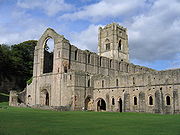 |
54.116111°N 1.573056°W |
Before the Dissolution of the Monasteries Dissolution of the Monasteries The Dissolution of the Monasteries, sometimes referred to as the Suppression of the Monasteries, was the set of administrative and legal processes between 1536 and 1541 by which Henry VIII disbanded monasteries, priories, convents and friaries in England, Wales and Ireland; appropriated their... in the mid-16th century, Fountains Abbey was one of the largest and richest Cistercian abbeys in Britain and is one of only a few that survives from the 12th century. The later garden, which incorporates the abbey, survives to a large extent in its original design and influenced garden design in Europe. |
||
| Tower of London Tower of London Her Majesty's Royal Palace and Fortress, more commonly known as the Tower of London, is a historic castle on the north bank of the River Thames in central London, England. It lies within the London Borough of Tower Hamlets, separated from the eastern edge of the City of London by the open space... |
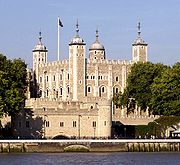 |
51.508056°N 0.076111°W |
Begun by William the Conqueror William I of England William I , also known as William the Conqueror , was the first Norman King of England from Christmas 1066 until his death. He was also Duke of Normandy from 3 July 1035 until his death, under the name William II... in 1066 during the Norman conquest of England Norman conquest of England The Norman conquest of England began on 28 September 1066 with the invasion of England by William, Duke of Normandy. William became known as William the Conqueror after his victory at the Battle of Hastings on 14 October 1066, defeating King Harold II of England... , the Tower of London is a symbol of power and an example of Norman military architecture that spread across England. Additions by Henry III Henry III of England Henry III was the son and successor of John as King of England, reigning for 56 years from 1216 until his death. His contemporaries knew him as Henry of Winchester. He was the first child king in England since the reign of Æthelred the Unready... and Edward I Edward I of England Edward I , also known as Edward Longshanks and the Hammer of the Scots, was King of England from 1272 to 1307. The first son of Henry III, Edward was involved early in the political intrigues of his father's reign, which included an outright rebellion by the English barons... in the 13th century made the castle one of the most influential buildings of its kind in England. |
||
| Westminster Palace, Westminster Abbey Westminster Abbey The Collegiate Church of St Peter at Westminster, popularly known as Westminster Abbey, is a large, mainly Gothic church, in the City of Westminster, London, United Kingdom, located just to the west of the Palace of Westminster. It is the traditional place of coronation and burial site for English,... and Saint Margaret's Church St. Margaret's, Westminster The Anglican church of St. Margaret, Westminster Abbey is situated in the grounds of Westminster Abbey on Parliament Square, and is the parish church of the House of Commons of the United Kingdom in London... |
51.499722°N 0.128611°W |
The site has been involved in the administration of England since the 11th century, and later the United Kingdom. Since the coronation of William the Conqueror, all English and British monarchs have been crowned at Westminster Abbey. Westminster Palace, home to the British Parliament Parliament of the United Kingdom The Parliament of the United Kingdom of Great Britain and Northern Ireland is the supreme legislative body in the United Kingdom, British Crown dependencies and British overseas territories, located in London... , is an example of Gothic Revival architecture Gothic Revival architecture The Gothic Revival is an architectural movement that began in the 1740s in England... ; St Margaret's Church is the palace's parish church, and although it pre-dates the palace and was built in the 11th century, it has been rebuilt since. |
Tentative list
The Tentative List is an inventory of important heritage and natural sites that a country is considering for inscription on the World Heritage List, thereby becoming World Heritage Sites. The Tentative List can be updated at any time, but inclusion on the list is a prerequisite to being considered for inscription within a five to ten year period.The UK's Tentative List was last updated on 19 January 2006, and consisted of 15 sites. The properties on the Tentative List are as follows:
Applicants for the tentative list
Following the review of UK World Heritage Policy begun in December 2008, the government proposed to submit a new Tentative List to UNESCO in 2011, with a view to re-commencing nominations to the World Heritage List beginning in 2012 and beyond, although not necessarily every year. Early in 2010 the government invited applications from local authorities and others, from throughout the UK, including the Overseas Territories and Crown Dependencies, for sites to be included on the new list. An independent expert panel was to be set up to advise Ministers on the applications, with a view to discouraging at an early stage, those applications which are unlikely to succeed. On 7 July 2010 the Department for Culture, Media and SportDepartment for Culture, Media and Sport
The Department for Culture, Media and Sport is a department of the United Kingdom government, with responsibility for culture and sport in England, and some aspects of the media throughout the whole UK, such as broadcasting and internet....
published a list of the 38 applicants received in the 2010 call for a new Tentative List, some of which were on the previous list. The 38 were:

